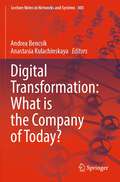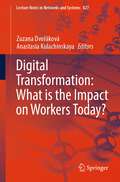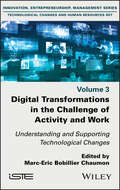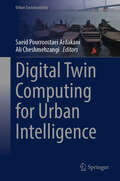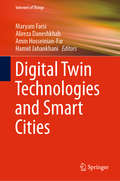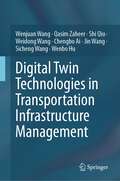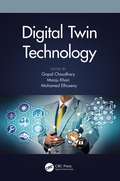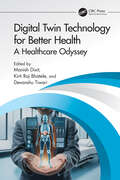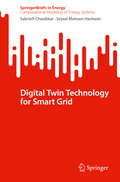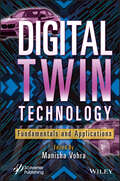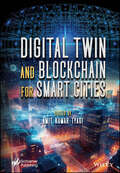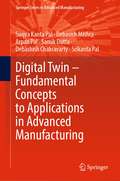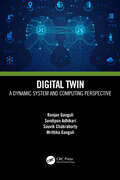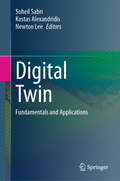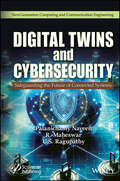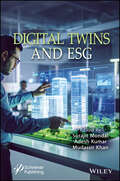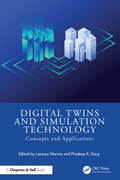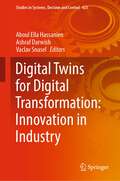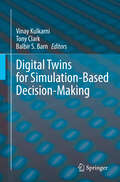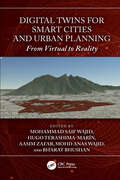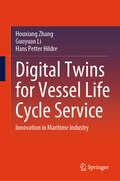- Table View
- List View
Digital Transformation: What is the Company of Today? (Lecture Notes in Networks and Systems #805)
by Anastasia Kulachinskaya Andrea BencsikThis book offers the latest research on organizational management, knowledge management, organizational functioning, organizational digitalization, and other issues of modern company development. The book proposes to look at the pool of these problems through the prism of building various models for implementing digital transformation of business and processes. This book is intended for both young and experienced scientists who want to get acquainted with latest trends and data to use them in their research.
Digital Transformation: What is the Impact on Workers Today? (Lecture Notes in Networks and Systems #827)
by Zuzana Dvořáková Anastasia KulachinskayaThis book offers the latest research on formation of modern workers in the context of digitalization: from constant improvement of new training technologies to growing requirements for employees in workplace, as well as an assessment of specialists' digital skills and dynamics of changes over the past years. The book proposes to look at the pool of these problems through the prism of acquisition of new digital competencies and requirements for a modern worker. This book is intended for both young and experienced scientists who want to get acquainted with latest trends and data to use them in their research.
Digital Transformations in the Challenge of Activity and Work: Understanding and Supporting Technological Changes
by Marc-Eric Bobillier ChaumonTECHNOLOGICAL CHANGES AND HUMAN RESOURCES SET Coordinated by Patrick Gilbert The accelerating pace of technological change (AI, cobots, immersive reality, connected objects, etc.) calls for a profound reexamination of how we conduct business. This requires new ways of thinking, acting, organizing and collaborating in our work. Faced with these challenges, the Human and Social Sciences have a leading role to play, alongside others, in designing, supporting and implementing these digital transformation projects. Their ambition is to participate in the development of innovative and empowering devices, that is to say, systems that are truly at the service of human beings and their activity, that empower these professionals to take action and that also provide occupational health services. This book takes a multidisciplinary look at the challenges of these digital transformations, making use of occupational psychology, ergonomics, sociology of uses, and management sciences. This viewpoint also helps provide epistemological, methodological and empirical insights to better understand and support the changes at work.
Digital Turn in Schools—Research, Policy, Practice: Proceedings of ICEM 2018 Conference (Lecture Notes in Educational Technology)
by Mart Laanpere Terje VäljatagaThis volume is a compilation of selected papers that were presented at the annual conference of the International Council of Educational Media (ICEM) in Tallinn, Estonia, on September 5 - 7, 2018. The book reports on recent interdisciplinary research and innovative practices regarding school-wide implementation of digital innovation and connects it with recent developments in the field of educational media. The key concept is “Digital Turn,” which is understood as a socio-technical transition towards next-generation digital learning ecosystems in education. Although Digital Turn can also be implemented at the classroom or national levels, most of the contributions in this volume take a whole-school perspective on the policies and practices regarding digital innovation, educational media, e-assessment, digital competences of teachers and students as well as learning design and learning analytics.
Digital Twin Adoption and BIM-GIS Implementation (Advanced Digital Technologies for the Built Environment)
by Sepasgozar, Samad M. E. Sara ShirowzhanThe aim of this edited book volume is to present new concepts, and applications of Digital Twin and relevant tools in the built environment context. The book identifies key organisational factors that influence the adoption of technology within the architectural service industry, setting the stage for a deeper understanding of the shift towards digital methodologies.The book introduces the Digital Twin Readiness Level framework, a modified metric system with ten levels of risk‑based maturity and an empirical development of a Digital Twin Adoption Model. Furthermore, the text ventures into immersive virtual environments and their applications, showcasing innovative practices that enhance learning and operational efficiency.Additionally, the book examines the integration of Building Information Modelling (BIM) and Geographic Information Systems (GIS), revealing new workflows for creating 3D models of cities. A focus on Australia’s government‑funded infrastructure projects offers insights into the values and acceptance criteria for these technologies, providing a comprehensive overview of their practical implications and future potential. This book is essential reading for practitioners, engineers, and managers involved in any phase of the built environment from design to operation and other architectural, engineering, and construction (AEC) stakeholders who are a part of digital transformations, as well as researchers, educators, and students interested in the field.
Digital Twin Computing for Urban Intelligence (Urban Sustainability)
by Ali Cheshmehzangi Saeid Pourroostaei ArdakaniDigital Twin Computing for Urban Intelligence focuses on new and ongoing discourses in interdisciplinary research and practice in urban system and smart city development pathways. It approaches digital twin fundamentals and principals including theoretical foundations, conceptualisations, strategies and services/patterns to define and adapt digital twin solutions for urban applications - mainly sustainability. This book highlights promising case studies and outlines digital twin design models and system architecture by examining key digital twin deployment practices such as data analysis, decision making, and service automation in the line with intelligent urban planning. It also emphasises on DT technologies such as cloud computing, AI, IoTs, and smart virtualisation and outlines the key benefits of the DT solutions in urban applications - mainly control and planning. This book is intended for a wide range of audiences, including interested layperson audiences, undergraduate and graduate students in university, and researchers. The key benefits of this book are: 1- To introduce the theoretical principles and fundamentals of DT computing for urban intelligence. 2- To present the state-of-the-art DT technologies in urban planning and control. 3- To describe the practical deployment process of DT computing solutions for urban sustainability and intelligence.
Digital Twin Driven Intelligent Systems and Emerging Metaverse
by Enis Karaarslan Ömer Aydin Ümit Cali Moharram ChallengerThis book covers the notion of the digital twin, which has the potential to alter the way systems are governed and manufactured. It also addresses the metaverse as an emerging technology with its roots in literature, cross-platform avatars, and artificial intelligence-oriented cybersecurity issues. The untapped potential of the metaverse and digital twins as enabling technologies for the next-generation industries is emphasized in various chapters. Digital twin technology enables manufacturers to comprehend their products throughout product design better, integrate simulation, tracking, and optimization in real-time, and appropriately analyze operations. Especially for complicated products or systems, testing on a digital twin is more efficient (more accessible, quicker, less error-prone, and less expensive). The product is examined in its virtual version before it is displayed in the actual world. Additionally, the digital twin minimizes operational expenses and increases the longevity of equipment and assets. By prolonging the life of the thing, they represent and enhance its working efficiency; it may minimize operating costs and prospective capital spending. The digital twin idea is becoming a reality as it has begun to be used in several industries, including energy, manufacturing, construction, transportation, aerospace, smart cities, healthcare, cyber security, finance, and agriculture. Academic and industrial experts highlighted the most compelling use cases of digital twins and metaverses and the challenges inherent in their implementation. Readers who want to make more effective systems will find the book useful. Also, people who want to get an idea and vision of how technology will change our lives will benefit from this book.
Digital Twin Technologies and Smart Cities (Internet of Things)
by Hamid Jahankhani Amin Hosseinian-Far Maryam Farsi Alireza DaneshkhahThis book provides a holistic perspective on Digital Twin (DT) technologies, and presents cutting-edge research in the field. It assesses the opportunities that DT can offer for smart cities, and covers the requirements for ensuring secure, safe and sustainable smart cities. Further, the book demonstrates that DT and its benefits with regard to: data visualisation, real-time data analytics, and learning leading to improved confidence in decision making;reasoning, monitoring and warning to support accurate diagnostics and prognostics;acting using edge control and what-if analysis; andconnection with back-end business applications hold significant potential for applications in smart cities, by employing a wide range of sensory and data-acquisition systems in various parts of the urban infrastructure. The contributing authors reveal how and why DT technologies that are used for monitoring, visualising, diagnosing and predicting in real-time are vital to cities’ sustainability and efficiency. The concepts outlined in the book represents a city together with all of its infrastructure elements, which communicate with each other in a complex manner. Moreover, securing Internet of Things (IoT) which is one of the key enablers of DT’s is discussed in details and from various perspectives. The book offers an outstanding reference guide for practitioners and researchers in manufacturing, operations research and communications, who are considering digitising some of their assets and related services. It is also a valuable asset for graduate students and academics who are looking to identify research gaps and develop their own proposals for further research.
Digital Twin Technologies in Transportation Infrastructure Management
by Jin Wang Weidong Wang Wenjuan Wang Qasim Zaheer Shi Qiu Chengbo Ai Sicheng Wang Wenbo HuThis book reveals the power of digital twin technologies in terms of optimizing the performance and maintenance of infrastructure assets. From roads, bridges, and tunnels to airports and smart cities, it will guide you through the latest advances in and use cases on this cutting-edge technology. You will come to understand the challenges involved in the development of digital twins and learn about the initiatives and projects underway to overcome them. Explore the potential of this technology in terms of reducing costs, improving system performance, and enhancing the overall infrastructure experience for users. Get ready to embark on a journey of understanding the future of transportation infrastructure management with digital twin technologies.
Digital Twin Technology
by Mohamed Elhoseny Manju Khari Gopal ChaudharyMost of the business sectors consider the Digital Twin concept as the next big thing in the industry. A current state analysis of their digital counterparts helps in the prediction of the future of physical assets. Organizations obtain better insights on their product performance through the implementation of Digital Twins, and the applications of the technology are frequently in sectors such as manufacturing, automobile, retail, health care, smart cities, industrial IoT, etc. This book explores the latest developments and covers the significant challenges, issues, and advances in Digital Twin Technology. It will be an essential resource for anybody involved in related industries, as well as anybody interested in learning more about this nascent technology. This book includes: The future, present, and past of Digital Twin Technology. Digital twin technologies across the Internet of Drones, which developed various perceptive and autonomous capabilities, towards different control strategies such as object detection, navigation, security, collision avoidance, and backup. These approaches help to deal with the expansive growth of big data solutions. The recent digital twin concept in agriculture, which offers the vertical framing by IoT installation development to enhance the problematic food supply situation. It also allows for significant energy savings practices. It is highly required to overcome those challenges in developing advanced imaging methods of disease detection & prediction to achieve more accuracy in large land areas of crops. The welfare of upcoming archetypes such as digitalization in forensic analysis. The ideas of digital twin have arisen to style the corporeal entity and associated facts reachable software and customers over digital platforms. Wind catchers as earth building: Digital Twins vs. green sustainable architecture.
Digital Twin Technology and Applications
by Srinivasan Sriramulu A Daniel N Partheeban Santhosh JayagopalanThe Fourth Industrial Revolution is being accelerated by the digital twin technological revolution, which converges intelligent technologies and defines the connectivity between physical and digital items. The Internet of Things (IoT) connects the real and digital worlds, allowing connected items to deliver a vast array of services to internet users. IoT devices create large amounts of data that may be fed into AI systems for decision- making. In a decentralized architecture, digital twin technology may be utilized to protect platforms and create smart contracts. Digital twins decentralized ledger, immutability, self- sovereign identification, and consensus procedures hold a lot of promise for improving AI algorithms. Furthermore, leveraging smart contracts in a digital twin system to facilitate user interaction via IoT might have a big influence, and this integrated platform is expected to revolutionize many fields.Digital Twin Technology and Applications examines the problems, issues, and solutions for using big data to enable streaming services using IoT and AI with digital twin technology. The IoT network concept is the key to success, and to establish a solid IoT platform on which large data transmission may take place, it must handle protocol, standards, and architecture. The book provides insight into the principles and techniques of IoT and AI. It explores the idea of using blockchain to provide security in a variety of sectors. The book also covers the application of integrated technologies to strengthen data models, improve insights and discoveries, innovate audit systems, as well as digital twin technology application to intelligent forecasting, smart finance, smart retail, global verification, and transparent governance.
Digital Twin Technology for Better Health: A Healthcare Odyssey
by Kirti Raj Bhatele Manish Dixit Devanshu TiwariAt a time when technology and healthcare are colliding to alter lives, Digital Twin Technology for Better Health: A Healthcare Odyssey throws open the revolutionary possibilities of digital twins in changing patient care, medical research, and healthcare operations. This book brings together the best of the best from healthcare, AI, and IT domains in providing a holistic and forward- looking study of one of the most innovative technologies of our times. Digital twin technology generally refers to the development of virtual replicas of physical entities. The functioning of healthcare systems is being transformed using this technology. Its applications lie in personalized treatment plans, predicting diagnostics results, optimized workflows in hospitals, and aid in the drug discovery process. The book examines the principles of digital twin technology in healthcare and their application in the real world and future directions. Features: Foundations and evolution of digital twin technology Applications in clinical care, including diagnosis, treatment, and patient monitoring Insights into how digital twins are changing the face of healthcare operations and management Case studies and practical examples illustrating real- world success stories Critical discussions on data security, ethical considerations, and regulatory frameworks Emerging trends and the integration of AI, IoT, and advanced analytics to enhance digital twin efficacy Whether you are a healthcare professional, technologist, researcher, or policymaker, this book is an indispensable guide to the science of how digital twin technology can help deliver better health. It is one of the earliest comprehensive works in the field and not only fills the gap between technology and healthcare but also serves as a visionary roadmap for the future. Let’s join in on this transition journey in healthcare toward the future, as digital twins promise to reshape the industry and change lives around the world.
Digital Twin Technology for Smart Grid (SpringerBriefs in Energy)
by Sabrieh Choobkar Seyed Mohsen HashemiThe traditional power grid has been revolutionized in recent years, and its different domains are improving to form a new smart grid. To better understand smart electricity grid and recommend how its domains function best, a comprehensive look at the power system in parallel with digitalization revolution is required. Recent digital twin (DT) technology promises to enhance industries, including smart grids, and this book studies DT architecture and its applications and benefits. Coverage includes DT solutions for smart grid domains and subsystems and describes advantages of employing DT in the smart grid. The book&’s concept is based on merging DT technology with smart grid applications. Its structure follows an understanding of DT concepts and applications in smart grid domains. Digital Twin Technology for Smart Power Grid will be a valuable reference for power industry practitioners, researchers, and students. It explains the new digital twin technology and how it can enhance the current electricity system toward a smarter power grid.
Digital Twin Technology: Fundamentals and Applications
by Manisha VohraDIGITAL TWIN TECHNOLOGY The book lucidly explains the fundamentals of digital twin technology along with its applications and various industrial real-world examples. Digital twin basically means a replicated model of any object or product in digital form. A digital twin has many advantages as it remains connected with the original object or product it is replicating and receives real-time data. Therefore, the obstacles and issues that could be encountered in a product or object can be known before their actual happening which helps to prevent errors and major losses which otherwise might have been incurred. The various capabilities of digital twin technology make it a powerful tool that can be used to effectively boost various sectors of the healthcare, automotive, and construction industries, among others. Although this technology has been making its way into various sectors, it has not yet received the kind of exposure necessary to increase awareness of its potential in these industries. Therefore, it is critical that a better understanding of digital twin technology is acquired to facilitate growth and to have it implemented in the various sectors so that transformation can be ushered in. Therefore, this book was designed to be a useful resource for those who want to become well acquainted with digital twin technology. Audience Engineers, researchers, and advanced students in information technology, computer science, and electronics, as well as IT specialists and professionals in various industries such as healthcare, automotive, and transportation.
Digital Twin and Blockchain for Smart Cities
by Amit Kumar TyagiThe book uniquely explores the fundamentals of blockchain and digital twin technologies and their uses in smart cities. In the previous decade, many governments explored artificial intelligence, digital twin, and blockchain, and their roles in smart cities. This book discusses the convergence of two transformative technologies, digital twin and blockchain, to address urban challenges and propel the development of smarter, more sustainable cities. This convergence empowers cities to create real-time replicas of urban environments (digital twins) and secure, transparent data management (blockchain) to improve city planning, management, and civic services. In this application, the concept of a digital twin involves creating a virtual, data-driven replica of a city or specific urban systems, such as transportation, energy, or infrastructure. This digital twin mirrors the real world, gathering data from various sensors, IoT devices, and other sources to provide a holistic view of the city’s operations. Furthermore, blockchain technology offers a decentralized and tamper-resistant ledger for securely storing and managing data. In the context of smart cities, blockchain can ensure data integrity, privacy, and transparency, enabling trust and collaboration among various stakeholders. This book covers many important topics, including real-time city modeling; data security and the trustworthy storage of sensitive urban data; transparent governance to facilitate accountable governance and decision-making processes in smart cities; improved city services; disaster resilience (by providing insights into vulnerabilities and efficient resource allocation during crises); sustainable urban planning that optimizes resource allocation, reduces energy consumption, and minimizes environmental impact, which fosters sustainable development; citizen engagement; and much more. This book will not only provide information about more efficient, resilient, and sustainable urban environments, but it also empowers citizens to be active participants in shaping the future of their cities. By converging these technologies, cities can overcome existing challenges, encourage innovation, and create more livable, connected, and responsive urban spaces. Audience This book has a wide audience in computer science, artificial intelligence, and information technology as well as engineers in a variety of industrial manufacturing industries. It will also appeal to economists and government/city policymakers working on smart cities, the circular economy, clean tech investors, urban decision-makers, and environmental professionals.
Digital Twin – Fundamental Concepts to Applications in Advanced Manufacturing (Springer Series in Advanced Manufacturing)
by Surjya Kanta Pal Debasish Mishra Arpan Pal Samik Dutta Debashish Chakravarty Srikanta PalThis book provides readers with a guide to the use of Digital Twin in manufacturing. It presents a collection of fundamental ideas about sensor electronics and data acquisition, signal and image processing techniques, seamless data communications, artificial intelligence and machine learning for decision making, and explains their necessity for the practical application of Digital Twin in Industry.Providing case studies relevant to the manufacturing processes, systems, and sub-systems, this book is beneficial for both academics and industry professionals within the field of Industry 4.0 and digital manufacturing.
Digital Twin: A Dynamic System and Computing Perspective
by Ranjan Ganguli Sondipon Adhikari Souvik Chakraborty Mrittika GanguliThe digital twin of a physical system is an adaptive computer analog which exists in the cloud and adapts to changes in the physical system dynamically. This book introduces the computing, mathematical, and engineering background to understand and develop the concept of the digital twin. It provides background in modeling/simulation, computing technology, sensor/actuators, and so forth, needed to develop the next generation of digital twins. Concepts on cloud computing, big data, IoT, wireless communications, high-performance computing, and blockchain are also discussed. Features: Provides background material needed to understand digital twin technology Presents computational facet of digital twin Includes physics-based and surrogate model representations Addresses the problem of uncertainty in measurements and modeling Discusses practical case studies of implementation of digital twins, addressing additive manufacturing, server farms, predictive maintenance, and smart cities This book is aimed at graduate students and researchers in Electrical, Mechanical, Computer, and Production Engineering.
Digital Twin: Fundamentals and Applications
by Newton Lee Soheil Sabri Kostas AlexandridisDigital twin technologies, currently at the forefront of development, play a crucial role in integrated systems, industrial design, manufacturing, data analytics, and decision-making processes. As we move forward, digital twin technologies, along with their enabling technologies such as Artificial Intelligence, Machine Learning, Internet of Things (IoT), metaverse, and advanced visualization features, will continue to drive digital transformation and innovation across various societal contexts. This book presents a conceptual framework that examines critical perspectives on digital twins across diverse disciplines. It evaluates the contributions of leading thinkers to the broader discourse about digital twins. The introductory chapter provides an overview of the entire book, summarizing all subsequent chapters. Chapter 2 delves into the fundamentals of digital twins, covering theories, definitions, and enabling technologies. Chapters 3 to 10 explore various application areas, including smart cities, manufacturing, healthcare, infrastructure, and supply chain. Chapter 10 specifically focuses on socio-technical aspects related to the design, development, and implementation of digital twins. It emphasizes the significance of digital twins as a public good and identifies opportunities, gaps, and challenges. The final chapter addresses the current and future need for skills in training, education, and awareness, proposing collaborative approaches for industry and academia.
Digital Twins and Cybersecurity: Safeguarding the Future of Connected Systems
by R. Maheswar Palanichamy Naveen U. S. RagupathyThis book serves as a comprehensive guide to understanding the complex relationship between digital twins and cybersecurity, providing practical strategies for safeguarding connected systems. This book explores the convergence of digital twins and cybersecurity, offering insights, strategies, and best practices for safeguarding connected systems. It examines the definition, evolution, types, and applications of digital twins across industries like manufacturing, healthcare, and transportation. Highlighting growing digital threats, it underscores the need for robust cybersecurity measures to protect the integrity and confidentiality of digital twin ecosystems. The book analyzes key components and infrastructure of digital twins, including data flow, communication channels, vulnerabilities, and security considerations. It also addresses privacy challenges and explores relevant regulations and compliance requirements. Guiding readers through implementing security measures, it presents a comprehensive cybersecurity framework, covering data protection, encryption, and strategies for ensuring data integrity and confidentiality. It also explores incident response and recovery, secure communication protocols, and the roles of gateways and firewalls. Industry-specific challenges and mitigation strategies are examined through real-world case studies, offering valuable insights and lessons learned. Emerging trends in digital twin technology are thoroughly explored, including the impact of advancements such as AI and quantum computing and their associated cybersecurity challenges and solutions. Audience This book is an essential resource for professionals in the fields of cybersecurity and industrial and infrastructure sectors, including manufacturing, healthcare, transportation, and other industries that utilize digital twins. Researchers in computer science, cybersecurity, engineering, and technology, as well as policymakers and regulatory bodies, will also find this book highly useful.
Digital Twins and ESG
by Adesh Kumar Surajit Mondal Mudassir KhanDigital Twins and ESG provides essential insight on how integrating cutting-edge Digital Twin technology with ESG practices can transform the understanding of sustainability and propel businesses towards a more transparent, accountable, and responsible future. Digital Twins and ESG introduces the dynamic world of ESG practices, emphasizing the pivotal role technology plays in shaping and advancing sustainability goals. It introduces readers to the multifaceted world of Digital Twin technology, offering a comprehensive understanding of its historical development and diverse applications across industries. This volume will intricately examine the integration of Digital Twins in ESG metrics and reporting frameworks. Artificial intelligence, machine learning, and blockchain technologies are also discussed as key enablers for achieving ESG goals, providing readers with a glimpse into the potential advancements and breakthroughs that lie ahead. Through detailed analyses and case studies, readers will gain insights into how Digital Twins enhance data collection, monitoring, and reporting, elevating transparency and accountability. Digital Twins and ESG serves as a rallying call, urging businesses to embrace Digital Twins as an integral component of their ESG strategies, ultimately paving the way for a more sustainable and responsible future.
Digital Twins and Simulation Technology: Concepts and Applications
by Lavanya Sharma and Pradeep K. GargThis book provides a comprehensive overview of the concept of digital twins, emphasising its strategic importance across various commercial domains. This book covers the fundamentals, data requirements, tools, and technologies essential for understanding and implementing digital twins. It discusses how digital twins are used for running simulations, analysing performance issues, and generating potential improvements to optimise business processes. The book explores the architecture, historical background, and real-time applications in sectors including urban planning, healthcare, smart cities, and manufacturing. Explains digital twin technology, including its core principles, architecture, and how it replicates physical objects in virtual platforms, in detail Covers the data types and tools necessary for creating and maintaining digital twins, including sensors, data processing systems, and integration methodologies Explores technologies such as Computer Vision, IoT, AI, ML, 5G, AR, and VR that drive the functionality and application of digital twins Analyses practical applications in diverse sectors like urban planning, smart cities, healthcare, manufacturing operations, and power-generation equipment, showcasing real-world use cases and benefits Examines real-time challenges and limitations associated with implementing digital twin technology, providing a balanced view of its capabilities and constraints It is a reference book for researchers, scholars, and students who are working or interested in learning about digital twin technology.
Digital Twins for Digital Transformation: Innovation in Industry (Studies in Systems, Decision and Control #423)
by Ashraf Darwish Vaclav Snasel Aboul Ella HassanienThis book aims to present dominant applications and use cases of the fast-evolving DT and determines vital Industry 4.0 technologies for building DT that can provide solutions for fighting local and globalmedical emergencies during pandemics. Moreover, it discusses a new framework integrating DT and blockchain technology to provide a more efficient and effective preventive conservation in different applications.
Digital Twins for Simulation-Based Decision-Making
by Tony Clark Balbir S. Barn Vinay KulkarniThis book introduces the concept of digital twins and their purposive usage, including the technology infrastructure and the method support necessary for their construction. The landscape of digital twins is illustrated through a range of use cases spread across different application domains such as strategy and business assessment in enterprises, logistics networks, manufacturing industries, chemical and refinery systems, sustainable food ecosystems, and public healthcare. All these examples show how digital twins are exploited to simulate complex scenarios depending on various external factors – all of which would not be feasible as real-world simulations because of their high costs, potential fatal damages, and unpredictable side effects. The book is written for professionals in industry who would like to learn about the application of these powerful methodologies and tools in various areas as well as for researchers in computer science who would like to draw inspirations for further development of this technology from real-world applications.
Digital Twins for Smart Cities and Urban Planning: From Virtual to Reality
by Bharat Bhushan Mohd Anas Wajid Aasim Zafar Mohammad Saif Wajid Hugo Terashima-MarínThis book discusses the concept of the digital twin, which has the potential to change how systems are managed and created. It also discusses the metaverse as a new technology with literary roots, cross-platform avatars, and artificial intelligence-related cybersecurity risks.Digital Twin for Smart Cities and Urban Planning: From Virtual to Reality provides practitioners with concrete problem-solving methodologies while covering the most recent and cutting-edge digital twin application technologies in diverse fields. It highlights the benefits of digital twins in terms of data visualization, real-time data analytics, and learning, which leads to increased confidence in decision-making. The book discusses the metaverse as a new technology with literary roots, cross-platform avatars, and artificial intelligence-related cybersecurity risks. It also evaluates the opportunities that DT can provide for smart cities and discusses the prerequisites for secure, safe, and sustainable smart cities. It also explores the mix between the industrial Internet of Things, artificial intelligence, machine learning, and software analytics with spatial network graphs to construct living digital simulation models that update and alter in response to changes in their physical counterparts. The chapters also focus on digital twin driven smart design which establishes a foundation for the adoption of digital twin technology in product design by drawing on the most recent industry practice and research.The book is an excellent resource for practitioners and scholars in manufacturing, operations research, and communications who are thinking about digitizing their assets and related services. It is also a helpful resource for graduate students and academics looking to better understand pioneering digital twins technologies.
Digital Twins for Vessel Life Cycle Service: Innovation in Maritime Industry
by Guoyuan Li Houxiang Zhang Hans Petter HildreThis book introduces the development of the digital twin of the marine infrastructure in Norway, which will be a significant scientific and operational achievement for the industry, making efficient and safe offshore operations possible. It enables data exchange safely and easily between different sub-systems, modules, and various applications. A complete digital twin ship will be presented in details. Thus, the twin ship can provide an integrated view of the ship’s various physical and behavioral aspects in different stages, and allow simultaneous optimization of functional performance requirements. In addition, it enables advanced control and optimization, e.g., creating more reliable prediction for flexible objectives (time, output, emissions, fuel consumption), and executing day-ahead and long-term planning for operations. More importantly, several related applications and case studies are presented in the end to confirm the effectiveness of the digital twin system. The research work is not only interesting for academia, also for industry.
